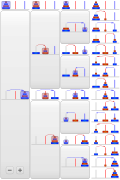
The ABACABA pattern is a recursive fractal pattern that shows up in many places in the real world (such as in geometry, art, music, poetry, number systems, literature and higher dimensions). Patterns often show a DABACABA type subset. AA, ABBA, and ABAABA type forms are also considered.
Generating the pattern
In order to generate the next sequence, first take the previous pattern, add the next letter from the alphabet, and then repeat the previous pattern. The first few steps are listed here.
| Step | Pattern | Letters |
|---|---|---|
| 1 | A | 2 − 1 = 1 |
| 2 | ABA | 3 |
| 3 | ABACABA | 7 |
| 4 | ABACABADABACABA | 15 |
| 5 | ABACABADABACABAEABACABADABACABA | 31 |
| 6 | ABACABADABACABAEABACABADABACABAFABACABADABACABAEABACABADABACABA | 63 |
ABACABA is a "quickly growing word", often described as chiastic or "symmetrically organized around a central axis" (see: Chiastic structure and Χ). The number of members in each iteration is a(n) = 2 − 1, the Mersenne numbers (OEIS: A000225).
Gallery
-
 Sierpinski triangle:
Sierpinski triangle:
ABACABA -
 Ruler, excluding 1 and 2:
Ruler, excluding 1 and 2:
ABACABADABACABAexcluding 2:
EABACABADABACABA -
 Cantor set:
Cantor set:
ABACABADABACABA -
 Binary tree/upside down family tree:
Binary tree/upside down family tree:
ABACABADABACABA -
 Koch curve: is ABA, is ABACABA, and : ABACABADABACABA
Koch curve: is ABA, is ABACABA, and : ABACABADABACABA
-
 Metric hierarchy:
Metric hierarchy:
ABACABADABACABA -
 Metric levels: EABACABADABACABA
Metric levels: EABACABADABACABA
-
 When counting in binary (here 4-bit), the final 0s form an ABACABA pattern
When counting in binary (here 4-bit), the final 0s form an ABACABA pattern
-
 A staircase built with the largest possible squares/cubes while allowing equally sized steps: ABACABADABACABA
A staircase built with the largest possible squares/cubes while allowing equally sized steps: ABACABADABACABA
-
 A "circle fractal" superimposed with a 2 × 2 box fractal: ABACABADABACABA
A "circle fractal" superimposed with a 2 × 2 box fractal: ABACABADABACABA
-
 The Tower of Hanoi with four disks: ABACABADABACABA
The Tower of Hanoi with four disks: ABACABADABACABA
-
 Binary tree array: to O
Binary tree array: to O
-
 Binary-reflected Gray code (BRGC): to G
Binary-reflected Gray code (BRGC): to G
-
 Rotary encoder: to I
Rotary encoder: to I
-
 3-bit Gray code visualized as a traversal of vertices of a cube (0,1,3,2,6,7,5,4): ABACABA
3-bit Gray code visualized as a traversal of vertices of a cube (0,1,3,2,6,7,5,4): ABACABA
-
 Double harmonic scale (Play) with steps of H-3H-H-W-H-3H-H: ABACABA
Double harmonic scale (Play) with steps of H-3H-H-W-H-3H-H: ABACABA
-
 Château de Chambord: ABACABA
Château de Chambord: ABACABA
-
 Gray code along the number line (OEIS: A003188): ABACABADABACABAEABACABADABACABA
Gray code along the number line (OEIS: A003188): ABACABADABACABAEABACABADABACABA
-
 Devil's needle: ABACABADABACABA
Devil's needle: ABACABADABACABA
-
 Size of hexagrams on a diagonal of a section of a Menger sponge model: ABACABADABACABA
Size of hexagrams on a diagonal of a section of a Menger sponge model: ABACABADABACABA
See also
Notes
- The strength, emphasis, or importance of the beginning of each duration the length of a single measure in
4 (eighth-notes) is, divisively (, , ), determined by each eighth-note's position in a DABACABA structure, while the eighth notes of two measures grouped, additively (), are determined by an EABACABADABACABA structure.
References
- ^ Naylor, Mike (February 2013). "ABACABA Amazing Pattern, Amazing Connections". Math Horizons. Retrieved June 13, 2019.
- ^ SheriOZ (2016-04-21). "Exploring Fractals with ABACABA". Chicago Geek Guy. Archived from the original on 22 January 2021. Retrieved January 22, 2021.
- ^ Naylor, Mike (2011). "Abacaba! – Using a mathematical pattern to connect art, music, poetry and literature" (PDF). Bridges. Retrieved October 6, 2017.
- ^ Conley, Craig (2008-10-01). Magic Words: A Dictionary. Weiser Books. p. 53. ISBN 9781609250508.
- Halter-Koch, Franz and Tichy, Robert F.; eds. (2000). Algebraic Number Theory and Diophantine Analysis, p.478. W. de Gruyter. ISBN 9783110163049.
- Wright, Craig (2016). Listening to Western Music, p.48. Cengage Learning. ISBN 9781305887039.
External links
- Naylor, Mike: abacaba.org
This fractal–related article is a stub. You can help Misplaced Pages by expanding it. |
 is ABA,
is ABA,  is ABACABA, and
is ABACABA, and  : ABACABADABACABA
: ABACABADABACABA
 the length of a single measure in
the length of a single measure in  ,
,  ,
,  ), determined by each eighth-note's position in a DABACABA structure, while the eighth notes of two measures grouped,
), determined by each eighth-note's position in a DABACABA structure, while the eighth notes of two measures grouped,  ), are determined by an EABACABADABACABA structure.
), are determined by an EABACABADABACABA structure.